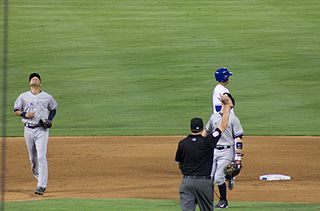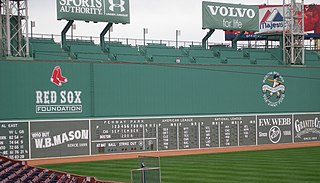
In baseball, a home run is scored when the ball is hit in such a way that the batter is able to circle the bases and reach home plate safely in one play without any errors being committed by the defensive team. A home run is usually achieved by hitting the ball over the outfield fence between the foul poles without the ball touching the field.

Softball is a popular variation of baseball, the difference being that it is played with a larger ball, on a smaller field, and with only underhand pitches permitted. Softball is played competitively at club levels, the college level, and the professional level. The game was first created in 1887 in Chicago by George Hancock.

A bunt is a batting technique in baseball or fastpitch softball. Official Baseball Rules define a bunt as follows: "A bunt is a batted ball not swung at, but intentionally met with the bat and tapped slowly within the infield." To bunt, the batter loosely holds the bat in front of home plate and intentionally taps the ball into play. A properly executed bunt will create weak contact with the ball and/or strategically direct it, forcing the infielders to make a difficult defensive play to record an out.

Catcher is a position in baseball and softball. When a batter takes their turn to hit, the catcher crouches behind home plate, in front of the (home) umpire, and receives the ball from the pitcher. In addition to this primary duty, the catcher is also called upon to master many other skills in order to field the position well. The role of the catcher is similar to that of the wicket-keeper in cricket.

The infield fly rule is a rule of baseball and softball that treats certain fly balls as though caught, before the ball is caught, even if the infielder fails to catch it or drops it on purpose. The umpire's declaration of an infield fly means that the batter is out regardless of whether the ball is caught. The rule exists solely to prevent the defense from executing a double play or triple play by deliberately failing to catch a ball that an infielder could catch with ordinary effort.
Dead ball is a term in many ball sports in which the ball is deemed temporarily not playable, and no movement may be made with it. Depending on the sport, this event may be quite routine, or more uncommon.

In baseball, a foul ball is a batted ball that:

In baseball, an out occurs when the umpire rules a batter or baserunner out. When a batter or runner is out, they lose their ability to score a run and must return to the dugout until their next turn at bat. When three outs are recorded in a half-inning, the batting team's turn expires.

Throughout baseball's history, the rules have frequently changed as the game continues to evolve. A few common rules most professional leagues have in common are that four balls are a base on balls, three strikes are a strikeout, and three outs end a half-inning.

A baseball field, also called a ball field or baseball diamond, is the field upon which the game of baseball is played. The term can also be used as a metonym for a baseball park. The term sandlot is sometimes used, although this usually refers to less organized venues for activities like sandlot ball.
In baseball, interference occurs in situations in which a person illegally changes the course of play from what is expected. Interference might be committed by players on the offense, players not currently in the game, catchers, umpires, or spectators. Each type of interference is covered differently by the rules.
In baseball, the rules state that a batted ball is considered in flight when it has not yet touched any object other than a fielder or his equipment. Such a ball can be caught by a fielder to put the batter out.

A ground rule double is a baseball rule that awards two bases from the time of pitch to all baserunners including the batter-runner, as a result of the ball leaving play after being hit fairly and leaving the field under a condition of the ground rules in effect at the field where the game is being played. An automatic double is the term used to refer to a fairly hit ball leaving the field in circumstances that do not merit a home run, such as when the ball's first bounce was within the field. The automatic double is commonly called a ground rule double.
The Knickerbocker Rules are a set of baseball rules formalized by William R. Wheaton and William H. Tucker of the Knickerbocker Base Ball Club in 1845. They have previously been considered to be the basis for the rules of the modern game, although this is disputed. The rules are informally known as the "New York style" of baseball, as opposed to other variants such as the "Massachusetts Game" and "Philadelphia town ball".

Ground rules are rules applying to the field, objects on and near it, and special situations relating to them, in the game of baseball. Major League Baseball has defined a set of "universal ground rules" that apply to all MLB ballparks; individual ballparks have the latitude to set ground rules above and beyond the universal ground rules, as long as they do not directly contradict each other. Additionally, a set of universal ground rules exists for the six MLB stadiums with retractable roofs, with the individual ballparks able to set additional rules.
This is an alphabetical list of selected unofficial and specialized terms, phrases, and other jargon used in baseball, along with their definitions, including illustrative examples for many entries.

Major League Baseball (MLB) uses instant replay review to allow league officials to review certain types of plays in order to determine the accuracy of the initial call of the umpires on the field. Reviews may be initiated either by a team's manager with limitations or by the umpires themselves. All instant replay reviews are examined by umpires at the Replay Command Center in New York City, who have the final decision as to whether to uphold or overturn the initial call.

The 2012 National League Wild Card Game was a play-in game during Major League Baseball's (MLB) 2012 postseason played between the National League's (NL) two wild card teams, the St. Louis Cardinals and the Atlanta Braves. It was held at Turner Field in Atlanta, on October 5, 2012, at 5:07 p.m. EDT. The Cardinals won by a 6–3 score and advanced to play the Washington Nationals in the NL Division Series. In addition to being the inaugural NL Wild Card Game, it is notable for being the final game of Chipper Jones’ career, as well as for a controversial infield fly rule call made by umpire Sam Holbrook. The game was televised on TBS.
Indian Ball is a "bat-and-ball" game featuring a baseball bat and ball. The sport originated in the late 1940s in St. Louis, Missouri so that if 18 players weren't available to play a regular baseball game, or a full sized field wasn't available, they could play an alternate game much like baseball but for fewer players.




















